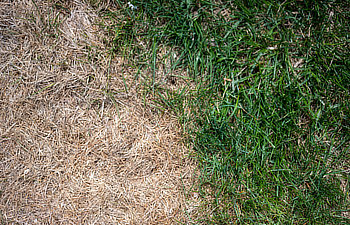
For every homeowner, a lush green lawn is a sight to behold. However, there might come a time when you look out and notice your once-vibrant grass looking brown and lifeless. It’s easy to panic and wonder, “Is my grass dead?” But before you worry too much, it’s essential to understand that grass can enter a dormant state. Let’s break down the differences between dead and dormant grass, so you know the best approach for your Georgia lawn.
- Dormant Grass: Grass enters a dormant state to protect itself from extreme conditions like drought or cold temperatures. While it might appear brown and dry, it’s essentially in a deep sleep, conserving energy. The roots remain alive, waiting for favorable conditions to turn green again.
- Dead Grass: If the grass is dead, it won’t come back to life. The roots and the blades have died. The primary causes can be disease, pests, or prolonged unfavorable conditions without intervention.
The Tug Test
One of the simplest ways to determine if your grass is dormant or dead is the tug test. Grasp a handful of brown grass and pull. If it comes out easily with no resistance and you can see the entire root, it’s likely dead. If it’s hard to pull out, your grass is dormant.
Check the Crown
The crown is the base of the grass where the blade meets the roots. If this part is white or cream-colored and firm to the touch, your grass is in a dormant state. If the crown is brown and brittle, it’s an indication that the grass might be dead.
Watering Patterns
If you’ve been experiencing a dry spell in Georgia, your lawn might go dormant as a protective measure. Try watering it deeply and consistently for a week and observe any green shoots. If there’s a sign of life, your grass was dormant. If not, you might be dealing with a dead lawn.
Consistency Across the Lawn
Dormant grass usually presents uniformly across the entire yard. If you notice random patches of brown, it’s more likely to be a disease or pest issue, suggesting the grass might be dead.
Time of Year
In Georgia, different grass types go dormant during various seasons. Warm-season grasses like Bermuda may turn brown during cooler months, while cool-season grasses like Fescue might brown during hot, dry summer months.
What To Do Next?
Here are some things you can do based on your findings:
- For Dormant Grass: Maintain regular watering and mowing schedules. Limit foot traffic to prevent further stress. Once the conditions are right, your lawn should bounce back.
- For Dead Grass: Consider seeking professional landscaping help. Mobile Joe’s Landscaping can assess the damage, determine the cause, and provide solutions, whether it’s reseeding patches or suggesting treatments.
Understanding your lawn’s state is crucial to providing the care it needs. A dormant lawn will recover, while a dead lawn might require more intervention. At Mobile Joe’s Landscaping, we’re here to guide you through every lawn challenge, ensuring you have a vibrant, green space to enjoy throughout the year. If you’re uncertain about your lawn’s state, don’t hesitate to reach out to our experts in Georgia.
Posted on behalf of
12460 Crabapple Rd. Suite 202 - 407
Alpharetta, GA 30004
Phone: (770) 360-5604
Email: infomobilejoes@gmail.com
Mon. - Fri. 8:30 AM – 7:00 PM
